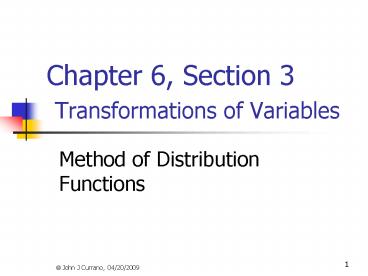Chapter 6, Section 3 Transformations of Variables - PowerPoint PPT Presentation
1 / 22
Title:
Chapter 6, Section 3 Transformations of Variables
Description:
Given some information about one or more random variables ... Let G(u) denote the cdf of U. Then. G(u) = for u 0, G(u) = for u 1, and for 0 u 1, ... – PowerPoint PPT presentation
Number of Views:45
Avg rating:3.0/5.0
Title: Chapter 6, Section 3 Transformations of Variables
1
Chapter 6, Section 3 Transformations of Variables
Method of Distribution Functions
? John J Currano, 04/20/2009
2
- The problem under consideration is the following
- Given some information about one or more random
variables (their cdfs, pdfs, mgfs), find the
distribution of some function of the random
variable(s). - We consider three techniques
- The Method of Distribution Functions (pdf or
cdf?? cdf ? pdf) - The Method of Transformations (pdf ?? pdf)
- The Method of Moment-Generating Functions (mgf ?
mgf) - We start with the Method of Distributions, which
is not usually used with discrete random
variables.
3
- Method of Distribution Functions Univariate
Continuous Case - Y is a random variable whose pdf, f (y), and/or
cdf, F (y), is known - U r (Y) for some function r
- G (u) and g (u) are the cdf and pdf,
respectively, of U - Then
which is F (b) F (a) if y r (y)
? u a, b , and g (u) G?(u).
4
Example 1. Y Uniform(?1, 1), so
U Y 2. Let G(u) denote the cdf of U.
Then G(u) for u 0, G(u) for u
1, and for 0 lt u lt 1, G(u)
Then Support(U) (0, 1).
0
1
P (Y 2 ? u )
P (U ? u )
.
5
Example 1. Y Uniform(?1, 1), so
U Y 2. For 0 lt u lt 1, G(u)
. But so that and therefore to
compute G(u), we can use the fact that Y is
uniform for 0 lt u lt 1.
6
Example 1. Y Uniform(?1, 1), so
U Y 2.
Thus,
and
so,
7
Example 2. (p. 307 6.2) Find the pdfs of U1 3Y
and U2 3 Y. Solution. This problem is
easier to do if we first find F(y)
8
U1 3Y U2 3 Y
Then
and
9
U1 3Y U2 3 Y
Also, G2(u) Pr(U2 u) Pr(3 Y u) Pr(Y
3 u) 1 Pr(Y 3 u)
10
U1 3Y U2 3 Y
So G2(u)
and
11
Method of Distribution Functions Bivariate
Continuous Case Example 3. (The procedure is
similar to the univariate case.)
12
(No Transcript)
13
Example 6.3 (Text, pages 301-304) (Y1, Y2) is a
random sample from the U(0, 1) distribution,
Here the shape of R and the limits of integration
depend on u
14
Example 4. (Y1, Y2) is uniformly distributed on
the region 0 lt y2 lt y1 lt 20. Find the
distribution of U Y1 Y2. Since the joint
support of (Y1, Y2) is a triangle with area 200,
Once again the shape of R and the limits of
integration depend on u
15
U Y1 Y2 Case 1 For u ? 0, G(u) 0. Case
2 For 0 lt u ? 20,
Since we have a uniform distribution, it can also
be calculated geometrically.
16
U Y1 Y2 Case 3 For 20 lt u ? 40,
Case 4 For u gt 40, G(u) 1.
17
Example 4. (Y1, Y2) is uniformly distributed on
the region 0 lt y2 lt y1 lt 20. Find the
distribution of U Y1 Y2.
18
Using geometry to calculate G(u) where U Y1
Y2
19
- Simulation of Distributions
- Assume
- U Uniform(0, 1), an easy distribution to
simulate Note FU(u) P(U u) u for 0
lt u lt 1. - X F(x) with F(x) strictly ? on Support(X)
Thus F(x) has an inverse F ?1 (0, 1) ?
Support(X) - V F ?1 (U)
- Then V has distribution function F that
is, - V and X have the same distribution.
- Therefore, V can be used to simulate X.
20
- Simulation of Distributions
- Proof. We are given
- U Uniform(0, 1), so P(U u) u for 0 lt u
lt 1 - X F(x) with F(x) strictly ? on Support(X)
- V F ?1(U)
- Then, for v ? F ?1 ( (0, 1) ) Support(X),
- FV (v) P(V v) P( F ?1(U) v )
- P( F ( F ?1(U) ) F(v) ) since F is ?
- P( U F(v) )
- F(v) by (1)
- Thus the distribution functions of V and X are
equal, so V X. - Note. Example 6.5 on p. 306 proves this fact when
X has an exponential distribution.
21
Example 4. (p. 309 6.17bc) Y belongs to the
power family with for parameters ??, ? gt 0. (b)
For fixed ? and ?, find a transformation G(u) so
that G(U) has distribution function F, where U
Uniform(0, 1). Then Y G(U).
Solution. By the previous example, we may take G
F sinceon Support(Y) (0, ? ),
is strictly increasing. To find G F , solve
?1
?1
Thus, if U Uniform(0, 1), then
22
(c) Suppose now that we wish to get a random
sample of size 5 from a power family
distribution with ? 2 and ? 4. We first
simulate a random sample of size 5 from
Uniform(0, 1). Suppose we obtain 0.2700, 0.6901,
0.1413, 0.1523, and 0.3609. We can use these
values, and the transformation to obtain a
sample of size 5 from Y
Sometimes we must evaluate G(u) by numerical
methods e.g., normal, ?? 2.































